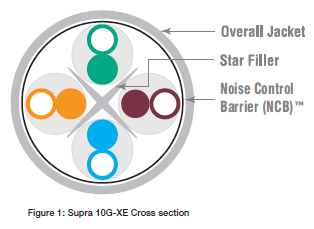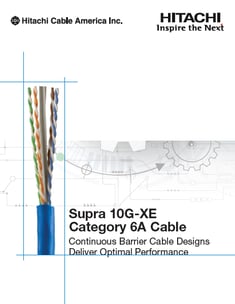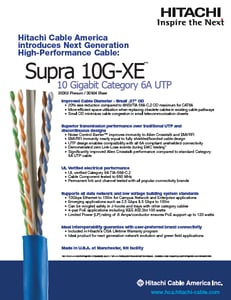Continuous Barrier Cable Designs Deliver Optimal Performance
Now that Category 6A has gained traction and has become the new standard for telecommunication infrastructure, the second generation of category 6A cables is taking over from their larger diameter counterparts. While the most obvious change is the reduction in the cable diameter, that diameter reduction requires an alternative approach to limiting the impact of external noise. The first generation of cables accomplished noise immunity with larger diameters that increased the distance between the cable cores. This second generation of cables utilizes various forms of shielding without requiring the bonding effort associated with F/UTP and other shielded cables.
telecommunication infrastructure, the second generation of category 6A cables is taking over from their larger diameter counterparts. While the most obvious change is the reduction in the cable diameter, that diameter reduction requires an alternative approach to limiting the impact of external noise. The first generation of cables accomplished noise immunity with larger diameters that increased the distance between the cable cores. This second generation of cables utilizes various forms of shielding without requiring the bonding effort associated with F/UTP and other shielded cables.
Category 6A cables are designed to support IEEE 802.3an 10GBase-T transmission. 10GBase-T operates at higher frequencies (standardized to 500 MHz) than lower performing systems and is more susceptible to external electronic noise in the form of Alien Crosstalk (AXT), which
is unwanted noise on a cable pair coupled from a pair in an adjacent cable, and noise generated by motors, fluorescent lighting and other electrical devices.
When it comes to overall performance of the category 6A cabling infrastructure, there are
3 designs that can be described as Good, Better and Best. UTP cables fulfill the “Good”
role. It is a proven technology that has been the standard for over 20 years. Alternative
barrier cable designs, which tend to have a smaller OD than standard UTP cables, offer
a “Better” solution since they take up less space than standard UTP cables and do not
need bonding & grounding like fully shielded cables do. However, some of these designs
do have limitations in regards to ensuring signal integrity. Fulfilling the “Best” role, fully
shielded systems provide the best immunity to outside electronic noise. Though once
found to be more difficult and costly to install than UTP solutions, shielded systems have
become more commonplace. Continue reading
Click below for more information




.png?width=58&height=58&name=X_logo_2023_(white).png)
